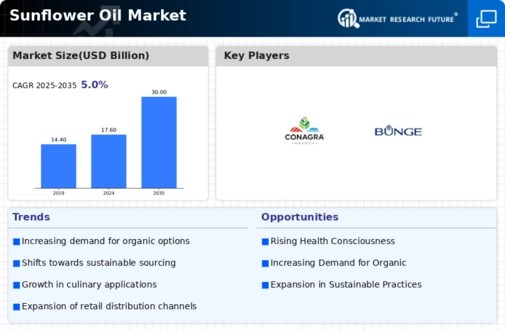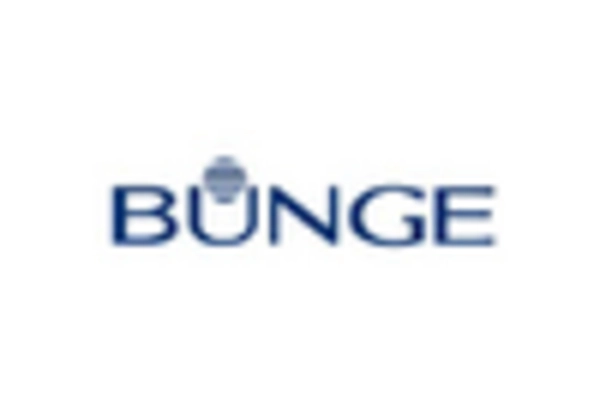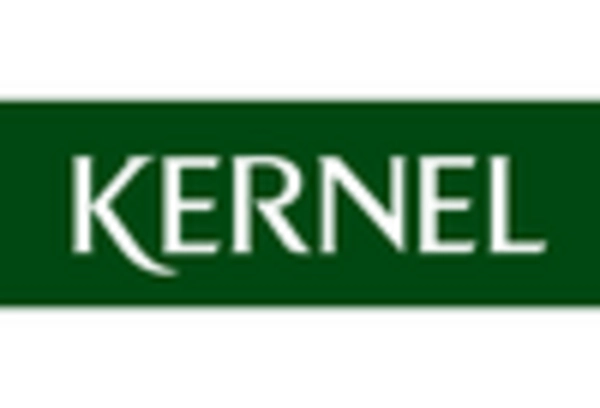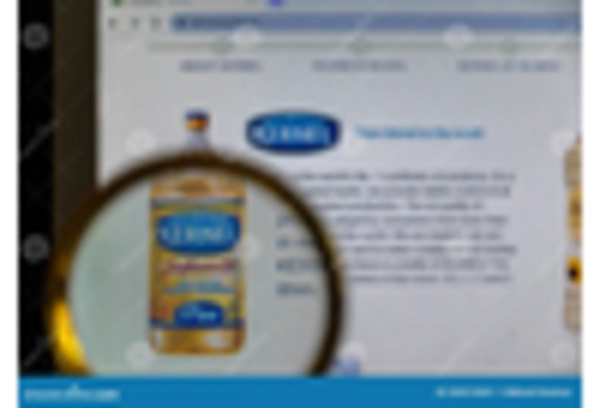Market Share
Introduction: Navigating the Competitive Landscape of Sunflower Oil
CURRENTLY THE MARKET FOR SUNFLOWER OIL IS IN THE MIDST OF A STAGE OF DYNAMIC CHANGE, prompted by technological innovations, changing preferences, and regulatory changes. Large-scale producers, niche organic brands, and new entrants are all competing for market leadership, each pursuing a different strategy. Smaller companies are focusing on the growing demand for organic and sustainable products. The large-scale producers are investing in automation and IoT technology to improve production efficiency and traceability. In addition, the rise of big data and the development of AI are enabling companies to better understand their customers’ needs and optimize their supply chains. Moreover, we expect the consumption of sunflower oil to grow steadily in the coming years, particularly in the Asia-Pacific and Latin America regions, where the growing awareness of the importance of healthy eating and the rising incomes are expected to drive demand. Strategic investment in green logistics and compliance with evolving food safety regulations will be crucial for companies that want to secure a place in this competitive market.
Competitive Positioning
Full-Suite Integrators
These vendors offer comprehensive solutions across the sunflower oil supply chain, from production to distribution.
| Vendor | Competitive Edge | Solution Focus | Regional Focus |
|---|---|---|---|
| Archer Daniels Midland Company | Global supply chain expertise | Agricultural processing and distribution | North America, Europe, Asia |
| Bunge Ltd. | Integrated agribusiness model | Oilseed processing and trading | Global presence |
| Cargill Incorporated | Diverse product portfolio | Food ingredients and oil production | Worldwide |
Specialized Technology Vendors
These companies focus on specific technologies or processes that enhance sunflower oil production and quality.
| Vendor | Competitive Edge | Solution Focus | Regional Focus |
|---|---|---|---|
| AAK AB | Specialized in value-adding solutions | Food ingredients and specialty oils | Europe, Asia, Americas |
| Colorado Mills | High-quality, non-GMO products | Sunflower oil production | North America |
Regional Producers
These vendors primarily focus on local markets, providing sunflower oil tailored to regional preferences.
| Vendor | Competitive Edge | Solution Focus | Regional Focus |
|---|---|---|---|
| Abu Dhabi Vegetable Oil Company (ADVOC) | Strong local market presence | Vegetable oil production | Middle East |
| Parakh Group | Established regional brand | Edible oils and fats | India |
| Rein Oil CC | Local sourcing and production | Sunflower oil manufacturing | Southern Africa |
| Macjerry Sunfloweroil Co. Ltd. | Focus on quality and sustainability | Sunflower oil production | Africa |
| Kaissaoil | Local market adaptability | Sunflower oil and derivatives | Asia |
Consumer Brands
These vendors are well-known consumer brands that market sunflower oil directly to end-users.
| Vendor | Competitive Edge | Solution Focus | Regional Focus |
|---|---|---|---|
| Conagra Brands, Inc. | Strong brand recognition | Consumer packaged goods | North America |
Emerging Players & Regional Champions
- SunPure Oils (India): Specializes in organic and cold-pressed sunflower oil, recently secured contracts with local organic food chains, challenging established vendors by focusing on health-conscious consumers.
- Golden Fields (Ukraine): Offers high-quality refined sunflower oil, recently expanded distribution in Eastern Europe, complementing established vendors by providing competitive pricing and local sourcing.
- Nature's Best (USA): Focuses on non-GMO sunflower oil products, recently partnered with major grocery retailers to enhance shelf presence, challenging traditional brands by emphasizing sustainability and health benefits.
- AgroTech (Argentina): Innovates in sunflower oil extraction technology, recently implemented a new processing plant that increases yield efficiency, complementing established vendors by offering advanced technology solutions.
Regional Trends: In 2022, there was a considerable increase in the consumption of organic and non-GMO sunflower oil, which was driven by the need to consume healthier foods. The use of new extraction and processing methods has become a priority for emerging companies, enabling them to compete with established companies. The regional champions have focused on local sourcing and sustainable production to establish their market position.
Collaborations & M&A Movements
- Cargill and Archer Daniels Midland Company (ADM) entered into a joint venture to enhance their sunflower oil production capabilities, aiming to increase market share in the growing health-conscious consumer segment.
- Bunge Limited acquired a controlling stake in a local sunflower oil processing plant in Ukraine to strengthen its supply chain and improve competitive positioning in the European market.
- Olam International partnered with local farmers in Argentina to promote sustainable sunflower oil production, enhancing their brand image and meeting increasing consumer demand for eco-friendly products.
Competitive Summary Table
| Capability | Leading Players | Remarks |
|---|---|---|
| Sustainability | Cargill, Bunge | The oil is produced in a manner that has been designed to minimize the impact on the environment. The supply chain is carefully controlled by Bunge, which has invested in traceability systems to ensure transparency and sustainability. |
| Quality Assurance | ADM, Olenex | ADM utilizes advanced quality control measures, including rigorous testing protocols to ensure product consistency. Olenex has established a reputation for high-quality sunflower oil through stringent quality checks and certifications. |
| Product Innovation | Sunola, Kraft Heinz | Sunola has introduced fortified sunflower oil products that cater to health-conscious consumers. Kraft Heinz has developed sunflower oil blends that enhance flavor profiles, appealing to culinary markets. |
| Distribution Network | Wilmar International, Cargill | Wilmar International boasts an extensive distribution network across Asia, ensuring wide availability of sunflower oil. Cargill leverages its global logistics capabilities to efficiently distribute products in various regions. |
| Consumer Engagement | Pinnacle Foods, Bunge | Pinnacle Foods has engaged consumers through targeted marketing campaigns highlighting the health benefits of sunflower oil. Bunge has utilized social media platforms to educate consumers about the versatility of sunflower oil in cooking. |
Conclusion: Navigating the Sunflower Oil Landscape
The sunflower oil market in 2022 is characterized by intense competition and a significant degree of fragmentation, with both established and new players competing for market share. According to regional trends, a growing preference for products from sustainable sources is driving the adaptation of vendors' strategies. Competition is also driven by the use of distribution and brand loyalty by established players, while new players rely on innovation and agility to capture niches. The ability to integrate advanced capabilities such as the use of artificial intelligence for predictive analysis, automation for operational efficiency, and a commitment to sustainable development will be critical to gaining a leadership position. As the market evolves, flexibility in strategic planning will be key to responding to changes in consumer preferences and competition.

















Leave a Comment